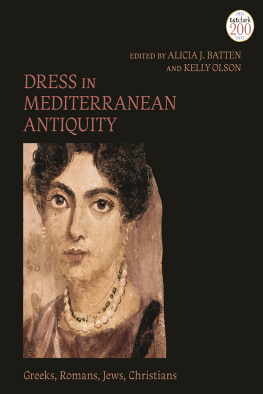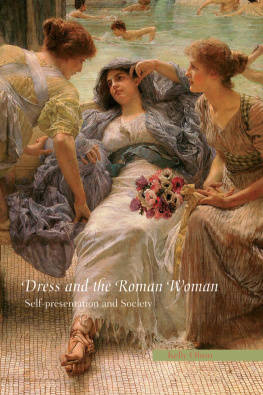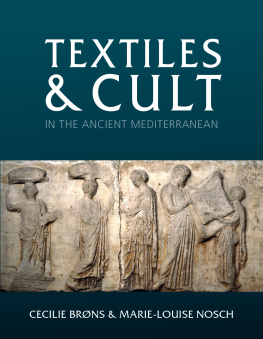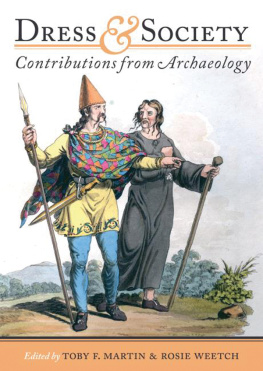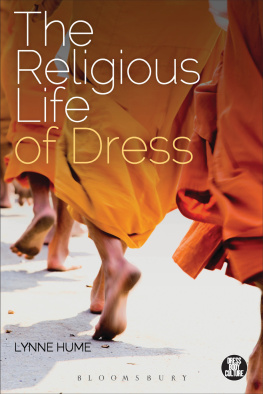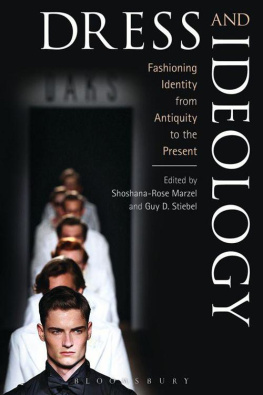DRESS IN MEDITERRANEAN ANTIQUITY
DRESS IN MEDITERRANEAN ANTIQUITY
GREEKS, ROMANS, JEWS, CHRISTIANS
Edited by Alicia J. Batten and Kelly Olson

Alicia dedicates this book to the memory of Andrew Bentham Batten (19632019), beloved brother, dressed in bright colours
Kelly dedicates this book to her colleague and friend James Miller, dandy extraordinaire.
Alicia is grateful to Terry Rothwell for many hours of assistance on the bibliography as well as for his valuable editorial help. Thanks are also due to Sandy Conrad and Carlo DeVito for their work on the bibliography. She is grateful to Conrad Grebel University College, University of Waterloo, for funding from the Academic Development and Research Fund to use colour images in the book. Finally, many thanks to Kelly, for being such an insightful, fun and fashionable co-editor.
Kelly would like to thank the Department of Classical Studies at the University of Western Ontario for help with administrative and research concerns, and Terry Rothwell for his work on the bibliography. James Miller, dapper friend and colleague, has provided nearly twenty years of cocktails and high fashion (I love our Fluevog Mondays!). And of course deep thanks to Alicia, whose brainchild this volume was.
Alicia and Kelly would both like to thank Dominic Mattos at Bloomsbury, who first suggested the idea of such a book, and Sarah Blake, at Bloomsbury, for guidance during its creation. We would be remiss if we also did not thank the city of Stratford, Ontario, for its charm, beauty, restaurants and shops. Meeting in Stratford to work on the book has been one of the many gifts of a collaborative venture such as this!
Alicia J. Batten is Professor of Religious Studies and Theological Studies at Conrad Grebel University College, University of Waterloo, Canada. She works in the area of the New Testament and Christian origins. Publications include Friendship and Benefaction in James (2010; repr., 2017), James, 1 and 2 Peter and Early Jesus Traditions (co-edited with John Kloppenborg, 2014) and Dressing Judeans and Christians in Antiquity (co-edited with Carly Daniel-Hughes and Kristi Upson-Saia, 2014, repr., 2016), as well as essays in edited collections and in journals, including New Testament Studies, Harvard Theological Review, Catholic Biblical Quarterly and Annali di storia dellesegesi.
Lise Bender Jrgensen is Professor Emeritus of Archaeology at the NTNU Norwegian University of Science and Technology, Department of Historical and Classical Studies. She is an internationally regarded expert in archaeological textiles from Europe and the Mediterranean world, with an extensive publication record that includes the monographs Forhistoriske textile I Skandinavien (Prehistoric Scandinavian Textiles) (1986) and North European Textiles until AD 1000 (1992). She is co-author of Creativity in the Bronze Age. Understanding Innovation in Pottery, Textile, and Metalwork Production (2018) and has published multiple articles on textiles from Roman Egypt.
Sue Blundell has lectured in Classical Studies at Birkbeck, University of London, and for the UKs Open University. Her main area of research is the history and representation of women in ancient Greece. She has also published work on Greek and Roman theories of evolution; Emma Hamiltons Classical Attitudes and their place in the eighteenth-century Grand Tour; and the symbolism of shoes in Greek art and thought.
Cecilie Brns is a classical archaeologist and senior researcher at the Ny Carlsberg Glyptotek in Copenhagen. She is the director of the museums polychromy project, which carries out interdisciplinary investigations of the original paint of the museums ancient artefacts. Her research focuses on ancient colours, particularly the polychromy of Greco-Roman art, as well as ancient textiles. She has published widely on the religious aspects of textile consumption in ancient Greece and on the polychromy of ancient art.
Lorelei H. Corcoran is Professor of Art History and Director of the Institute of Egyptian Art & Archaeology at the University of Memphis, TN. She received her BA in Classical Studies from Tufts University and a PhD in Near Eastern Languages and Civilizations (Egyptology) from the University of Chicago. Her publications include the multidisciplinary study, Portrait of a Child: Historical and Scientific Studies of a Roman Egyptian Mummy (2019); Herakleides: A Portrait Mummy from Roman Egypt (2010), with Marie Svoboda; and Portrait Mummies from Roman Egypt (IIVth Centuries A.D.) with a Catalog of Portrait Mummies in Egyptian Museums (1995).
Glenys Davies is Honorary Fellow in the School of History, Classics and Archaeology at the University of Edinburgh, having retired four years ago from her post of lecturer/senior lecturer in Classical Art and Archaeology there, which she held for thirty-eight years. Retirement has allowed for the publication of her long-standing major project: Gender and Body Language in Roman Art (Cambridge University Press, 2018). She continues to carry out research into various aspects of Roman art, dress and society.
Andrew Gallia is Associate Professor of History at the University of Minnesota. He is the author of Remembering the Roman Republic: Culture, Politics and History under the Principate (2012) and several articles on Roman history and culture. He is currently working on a study of rudeness in Roman society.
Laura Gawlinski is Associate Professor and Chair of Classical Studies at Loyola University Chicago. She is co-editor with Megan Cifarelli of What Shall I Say of Clothes? Theoretical and Methodological Approaches to the Study of Dress in Antiquity (Archaeological Institute of America, 2017) and the author of The Sacred Law of Andania: A New Text with Commentary (De Gruyter, 2012). She has been involved with the excavations of the Athenian Agora for twenty-five years and authored the guide to its museum, which was published in 2014.
Beth E. Graybill is a qualitative sociologist whose research focuses exclusively on Anabaptist peoples. She received her PhD in American Studies and certification in gender studies from the University of Maryland in 2010. Prior to that, Graybill received the Kreider Fellowship at the Young Center for Pietist and Anabaptist Studies at Elizabethtown College. She has served visiting professor appointments at Franklin and Marshall College, Dickinson College and Millersville University in Central Pennsylvania. Beth has published on Amish fiction, plain dress and gender, womens entrepreneurship and Amish tourism, using ethnographic methodology. She has been researching topics related to Mennonite and Amish women for the past twenty years.
Lisa A. Hughes is Associate Professor of Classics and Religion at the University of Calgary. Hughess research focuses on visual representations of non-elites in the late Republic and early Empire. She has focused on the visual vocabulary of funerary monuments with an emphasis on gender. Her new project explores the role of small-scale theatrical performances in the gardens of ancient Roman houses. Publications include Unveiling the Veil: Social, Cultic, and Ethnic Representations of Early Imperial Freedwomen Material Religion: The Journal of Objects, Art and Belief 3.2 (2007): 21841 and Sculpting Theatrical Performance at Pompeiis Casa Degli Amorini Dorati LOGEION: A Journal of Ancient Theatre 4 (2014): 22747.
Lynne Hume is Associate Professor and Honorary Research Consultant at the University of Queensland, Australia. While her main focus has been anthropology and religion, her research has led her in many different geographical, theoretical and thematic directions, the most recent being anthropology of the senses and material anthropology. Recent work includes Spiritual Black (2020), in
Next page
